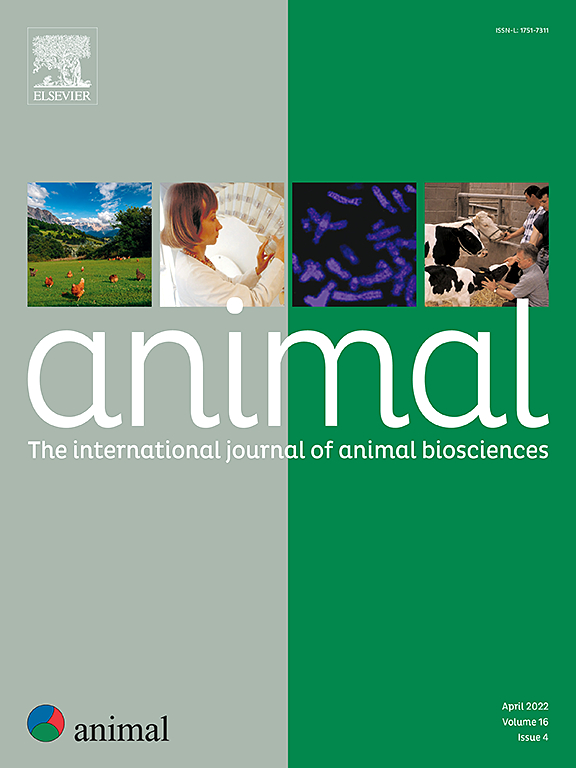Exploring genetic diversity and genomic inbreeding across local beef cattle breeds
IF 4.2
2区 农林科学
Q1 AGRICULTURE, DAIRY & ANIMAL SCIENCE
引用次数: 0
Abstract
Beef cattle breeds from Central and Southern Italy, such as Marchigiana, Chianina, Romagnola, Maremmana, and Podolica, represent a unique genetic resource shaped by centuries of natural and artificial selection. Their origin, partly linked to the Podolian group, remains debated, while their adaptation to diverse environments and close association with regional economies enhance their zootechnical and cultural value. Despite their importance, comprehensive assessments of their genomic diversity are still limited, especially in an international context where preserving local breeds is crucial to maintain global biodiversity and resilience in livestock systems. This study investigates population structure, inbreeding, selection signatures, and effective population size using medium-density single-nucleotide polymorphism genotypes. Multivariate and clustering approaches confirmed clear genetic differentiation among breeds, with Chianina and Romagnola being the most divergent, in line with their intensive selection history. In contrast, Maremmana and Podolica displayed shared ancestral components, reflecting their adaptation to extensive and marginal environments. Pairwise Fst values supported these patterns of divergence, while the phylogenetic tree grouped specialised beef breeds (Marchigiana, Chianina, Romagnola) separately from the more rustic ones (Maremmana and Podolica). Historical Ne trajectories revealed long-term contraction in Chianina and Romagnola, whereas Podolica maintained higher Ne over time. Runs of homozygosity (ROH) were used to estimate inbreeding coefficients (FROH) and to distinguish ancient (ROH ≤ 4 Mb) from recent inbreeding (ROH ≥ 8 Mb). Chianina exhibited the highest FROH values, mainly composed of shorter ROH, suggesting older inbreeding episodes. ROH islands were detected on BTA5 and BTA6 and included genes such as FGF5, RAB21, KRT71, and DCAF16, which are linked to coat characteristics, growth, and environmental adaptation. Gene Ontology enrichment analyses indicated their involvement in relevant biological functions. Overall, this study provides a comprehensive genomic characterisation of five Italian beef cattle breeds, emphasising their differentiation, demographic history, and signatures of selection. These findings enhance the understanding of local genetic resources and contribute to broader strategies for the conservation and sustainable use of animal biodiversity in the face of global challenges.
探索地方肉牛品种的遗传多样性和基因组近交
意大利中部和南部的肉牛品种,如Marchigiana、Chianina、Romagnola、Maremmana和Podolica,代表了经过几个世纪的自然和人工选择形成的独特遗传资源。他们的起源,部分与波多利亚人有关,仍然存在争议,而他们对不同环境的适应以及与区域经济的密切联系,提高了他们的动物技术和文化价值。尽管它们很重要,但对其基因组多样性的全面评估仍然有限,特别是在保护地方品种对维持全球生物多样性和牲畜系统的复原力至关重要的国际背景下。本研究利用中密度单核苷酸多态性基因型研究群体结构、近交、选择特征和有效群体大小。多变量和聚类方法证实了品种间明显的遗传分化,其中Chianina和Romagnola的差异最大,这与它们密集的选择历史相一致。相比之下,Maremmana和Podolica表现出共同的祖先成分,反映了它们对广泛和边缘环境的适应。成对的Fst值支持这些分化模式,而系统发育树将专门的牛肉品种(Marchigiana, Chianina, Romagnola)与更质朴的牛肉品种(Maremmana和Podolica)分开分组。历史上的Ne轨迹显示中国和罗马的长期收缩,而波多里卡则保持较高的Ne。纯合子(ROH)序列用于估计近交系数(FROH),并区分古代近交(ROH≤4 Mb)和近代近交(ROH≥8 Mb)。中国的FROH值最高,主要由较短的ROH组成,表明近交期较早。在BTA5和BTA6上检测到ROH岛,包括FGF5、RAB21、KRT71和DCAF16等基因,这些基因与被毛特性、生长和环境适应性有关。基因本体富集分析表明它们参与了相关的生物学功能。总体而言,本研究提供了五个意大利肉牛品种的全面基因组特征,强调了它们的分化、人口统计学历史和选择特征。这些发现增进了对当地遗传资源的了解,并有助于在面临全球挑战的情况下制定保护和可持续利用动物生物多样性的更广泛战略。
本文章由计算机程序翻译,如有差异,请以英文原文为准。
求助全文
约1分钟内获得全文
求助全文
来源期刊

Animal
农林科学-奶制品与动物科学
CiteScore
7.50
自引率
2.80%
发文量
246
审稿时长
3 months
期刊介绍:
Editorial board
animal attracts the best research in animal biology and animal systems from across the spectrum of the agricultural, biomedical, and environmental sciences. It is the central element in an exciting collaboration between the British Society of Animal Science (BSAS), Institut National de la Recherche Agronomique (INRA) and the European Federation of Animal Science (EAAP) and represents a merging of three scientific journals: Animal Science; Animal Research; Reproduction, Nutrition, Development. animal publishes original cutting-edge research, ''hot'' topics and horizon-scanning reviews on animal-related aspects of the life sciences at the molecular, cellular, organ, whole animal and production system levels. The main subject areas include: breeding and genetics; nutrition; physiology and functional biology of systems; behaviour, health and welfare; farming systems, environmental impact and climate change; product quality, human health and well-being. Animal models and papers dealing with the integration of research between these topics and their impact on the environment and people are particularly welcome.
 求助内容:
求助内容: 应助结果提醒方式:
应助结果提醒方式:


